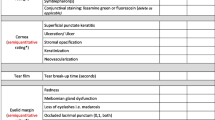Abstract
Objective: To review 10 years’ experience in a tertiary care paediatric hospital of erythema multiforme (EM), Stevens-Johnson syndrome (SJS) and toxic epidermal necrolysis (TEN). In addition, to apply a recently described classification system for EM, SJS and TEN in children.
Design: Retrospective study of all children with a discharge diagnosis of EM, SJS or TEN over a 10-year period.
Setting: A university tertiary care paediatric hospital.
Patients: Sixty-one paediatric patients with a discharge diagnosis of EM, SJS or TEN.
Main Outcome Measures: Epidemiology, laboratory features, causative factors, treatment methods, complications and mortality of EM, SJS and TEN in this group of patients. Comparison of correlation with aetiology of old and new classification systems in a paediatric population.
Results: Mucous membrane involvement was documented in 61% of patients. Ocular involvement was seen in 39%. Complications occurred in 21% cases, all of whom had SJS or TEN. Only one patient died as a result of their skin condition. Corticosteroids were used in 18% of cases; 95% of whom had a discharge diagnosis of SJS or TEN. The drugs most commonly identified as aetiological agents were sulphonamides and penicillins (26% each). The most frequently implicated infectious agent was herpes simplex virus (19.7%).
Classification of study cases according to Bastuji-Garin et al. indicates a strong trend toward bullous EM cases being attributable to infection and SJS/TEN cases to drugs. There was no such clear trend with respect to aetiology when diagnosis was done without the classification system.
Conclusion: EM, SJS and TEN rarely cause mortality but significant morbidity is seen. Infectious agents, particularly herpes simplex virus, and drugs, especially the sulphonamides and penicillins, are the most common aetiological agents. The classification system proposed by Bastuji-Garin et al. correlates better with aetiology than the practice that preceded it.






Similar content being viewed by others
References
Huff JC, Weston WL, Tonnesen MG, et al. Erythema multiforme: a critical review of characteristics, diagnostic criteria, and causes. J Am Acad Dermatol 1983 8: 763–75
Roujeau JC, Stern RS. Severe adverse cutaneous reactions to drugs. N Engl J Med 1994; 331: 1272–85
Schopf E, Stuhmer A, Rzany B, et al. Toxic epidermal necrolysis and Stevens-Johnson Syndrome: an epidemiologic study from West Germany. Arch Dermatol 1991; 127(6): 839–42
Revuz J, Penso D, Roujeau JC, et al. Toxic epidermal necrolysis: clinical findings and prognosis in 87 patients. Arch Dermatol 1987 123: 1160–5
Mockenhaupt M, Schopf E. Epidemiology of drug induced severe skin reactions. Semin Cutan Med Surg 1996; 15: 236–43
Schofield JK, Tatnall FM, Leigh IM. Recurrent erythema multiforme: clinical features and treatment in a large series of patients. Br J Dermatol 1993; 128: 542–5
Levy M, Shear NH. Mycoplasma pneumoniae infections and Stevens-Johnson syndrome: report of eight cases and review of the literature. Clin Pediatr 1991; 30: 42–9
Kampgen E, Burg G, Wank R. Association of herpes simplex virus induced erythema multiforme with the human leukocyte antigen DQw3. Arch Dermatol 1988; 124: 1372–5
Roujeau JC, Guillaume JC, Febre JP, et al. Toxic epidermal necrolysis (Lyell’s syndrome) incidence and drug etiology in France, 1981-1985. Arch Dermatol 1990 126: 37–42
Guillaume JC, Roujeau JC, Penso D, et al. The culprit drugs in 87 cases of toxic epidermal necrolysis (Lyell’s syndrome). Arch Dermatol 1987 123: 1166–70
Chan HL, Stern RS, Arndt KA, et al. The incidence of erythema multiforme, Stevens-Johnson syndrome, and toxic epidermal necrolysis: a population-based study with particular reference to cutaneous reactions caused by drugs among outpatients. Arch Dermatol 1990; 26: 43–7
von Hebra F. On diseases of the skin including the exanthemata, translated by CH Fagge. London: New Sydenham Society, 1866; (1): 285–9
Stevens AM, Johnson FC. A new eruptive fever associated with stomatitis and ophthalmia: report of two cases in children. Am J Dis Child 1922; 24: 526–33
Lyell A. Toxic epidermal necrolysis: an eruption resembling scalding of the skin. Br J Dermatol 1956; 68: 355–61
Kennett S. Erythema multiforme affecting the oral cavity. Oral Surg 1968; 25: 366–73
Thomas BA. The so-called Stevens-Johnson syndrome. BMJ 1950; 1: 1393–7
Paquet P, Pierard GE. Erythema multiforme and toxic epidermal necrolysis: a comparative study. Am J Dermatopathol 1997; 19: 127–32
Bastuji-Garin S, Rzany B, Stern RS, et al. Clinical classifications of cases of toxic epidermal necrolysis, Stevens-Johnson Syndrome, and erythema multiforme.. Arch Dermatol 1993 129: 92–6
Assier H, Bastuji-Garin S, Revuz J, et al. Erythema multiforme with mucous membrane involvement and Stevens-Johnson Syndrome are clinically different disorders with distinct causes. Arch Dermatol 1995 131: 539–43
Patterson R, Dykewicz MS, Gonzales A, et al. Erythema multiforme and Stevens-Johnson Syndrome: descriptive and therapeutic controversy. Chest 1990 98: 331–6
Patterson R, Miller M, Kaplan M, et al. Effectiveness of early therapy with corticosteroids in Stevens-Johnson Syndrome: experience with 41 cases and a hypothesis regarding pathogenesis. Ann Allerg 1994 73: 27–34
Viard I, Wehrli P, Bullani R, et al. Inhibition of toxic epidermal necrolysis by blockade of CD95 with human intravenous immunoglobulin. Science 1998 282: 490–3
Acknowledgements
Dr Gideon Koren is a senior scientist of the Canadian Institute for Health Research. The study was supported by The Motherisk Research Fund, Hospital for Sick Children, Toronto, Canada.
Author information
Authors and Affiliations
Corresponding author
Rights and permissions
About this article
Cite this article
Forman, R., Koren, G. & Shear, N.H. Erythema Multiforme, Stevens-Johnson Syndrome and Toxic Epidermal Necrolysis in Children. Drug-Safety 25, 965–972 (2002). https://doi.org/10.2165/00002018-200225130-00006
Published:
Issue Date:
DOI: https://doi.org/10.2165/00002018-200225130-00006




